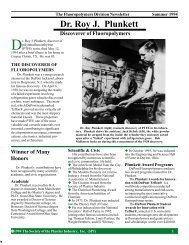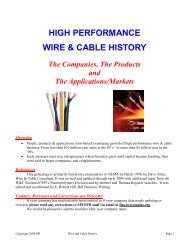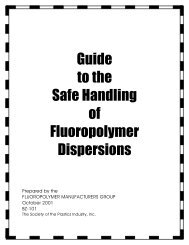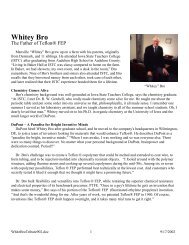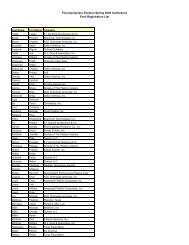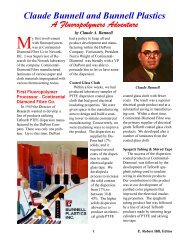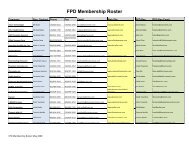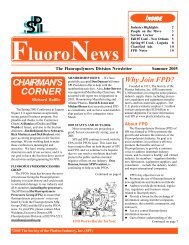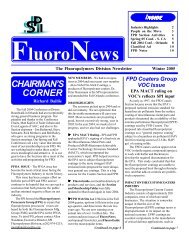It's Your Industry Too! - Fluoropolymers Division
It's Your Industry Too! - Fluoropolymers Division
It's Your Industry Too! - Fluoropolymers Division
You also want an ePaper? Increase the reach of your titles
YUMPU automatically turns print PDFs into web optimized ePapers that Google loves.
Omer Plourde - from page 1<br />
developing many of the processes and products that are made today by DeWAL and its competitors.<br />
BEGINNING AT DIXON<br />
Omer entered the PTFE industry in 1966 at Dixon Industries in Bristol, RI as a lathe operator in<br />
the fabrication department, then skiving lathe operator, and later lead person in skiving. Dixon<br />
was vertically integrated in all aspects of PTFE production. He worked with people like Saul<br />
Ricklin, Robert Rulon-Miller, Jack Holland, Bert Katznak and Ted Rulon – Miller. It was a great<br />
start to an impressive career. He was soon promoted to supervisor with responsibilities for billet<br />
molding then to Dept. Head with responsibilities for powder preparation (Blending) and Etching.<br />
The College of Hands On… Right after joining Dixon, Omer earned an Associates Degree in<br />
Business at night, then starting taking Engineering courses at Roger Williams University. He had<br />
to stop due to overload with new family, work, and working nights for his father to help him out<br />
of a jam. Omer said, “Everything I learned in the industry was by getting my hands dirty,<br />
volunteering, and getting involved.” He learned billet molding, skiving, blending, etching, ram<br />
extrusion, making free/low flow resins, laminates, fabrication of parts, stamping, etching, slitting,<br />
etc. on his own.<br />
Corporate Duties… Omer was transferred to Corporate administration , reporting to Bundy VP,<br />
to implement a Hewlett Packard MRP computer system which would be the groundwork for<br />
expansion to the other Dixon <strong>Industry</strong> manufacturing sites. This required 2 years of his time.<br />
After accomplishing this project, his new objective was to identify and rectify a poor profit<br />
situation caused by inventory, productivity and system problems at one of the other facilities<br />
within the group. Omer spent a year on this project, which eventually led to closing down the<br />
facility and transferring equipment to 3 other facililites.<br />
Bearing Wear Pads for Alaskan Pipeline (1975-1977)… Dixon received the “largest single PTFE<br />
order ever placed” for bearing wear pads for the Alaskan pipeline. Product was a proprietary filled<br />
PTFE compound skived/etched then bonded to stainless steel plates, drilled, machined and polished.<br />
Volume was approximately 300k lbs of a special formulation that needed to be blended, pulverized,<br />
billet molded, sintered/ skived and sodium etched. Omer’s responsibility was to make this happen<br />
then transfer the pads to their bonding department for finishing to a wear plate. These pads were<br />
installed on the piers that supported the actual pipeline to allow the pipeline to move due to seasonal<br />
contraction of the pipeline steel.<br />
PTFE Film for Russia (1978-1979)… Right after the pipeline job, Dixon won a quote for a special<br />
PTFE product destined for Russia. The product was for PTFE film skived and calendered to 1.5, 2.0,<br />
and 3.5 mils thick in various widths. Omer was assigned Project Manager for this job. They hired all<br />
the necessary personnel for a 3 shift operation and purchased all necessary equipment. The primary<br />
piece was an old Waterbury Calender which was rebuilt and retooled with periphery multiple<br />
payoff and takeoff stations. They ran a 3 shift operation successfully, and shipped the 100k lbs<br />
order to Moscow.<br />
Omer ca. 1990<br />
“Bullwinkle” Job (1985)… Omer was also involved another unique job − the production<br />
of large PTFE bearing wear pads for the “Bullwinkle” job. This was the largest oil drilling<br />
derrick in the world. The derrick was constructed on its side, atop bonded 4’ x 10’ pads.<br />
The derrick was 1800’ long and 425’ square at the base. The construction took place along<br />
the intercoastal waterway near Corpus Christi, Texas. The top of the derrick had aircraft<br />
warning lights installed. After construction was complete, the derrick was maneuvered<br />
down a ramp on the PTFE filled bonded wear pads onto a barge to be towed to the<br />
Manatee Oil Field, 160 miles Southwest of New Orleans. The entire project cost $500<br />
million, and surpassed the Alaskan pipeline job in PTFE volume by over 2.5x.<br />
to Omer Plourde on page 7<br />
FLUORONEWS | SUMMER 2008 | PAGE 6<br />
PI)





